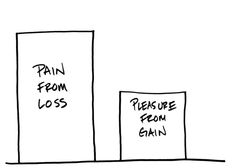As the famous song goes, ‘You’ve gotta accentuate the positive, eliminate the negative’, which makes sense right up to the point when you want to persuade someone of the benefits of making a change.
It turns out that the human brain feels the pain of loss much more strongly than it feels the joy of gain. Current loss looms larger than future gain. This effect is called loss aversion.
The Research
Research done by the University of California showed that home owners were up to 300% more likely to undertake energy efficiency upgrades if the they were told they were losing 50 cents a day rather than being told they would save 50 cents a day. Obviously, the financial outcome of both messages is the same but the psychological pain of loss is a much greater motivator for change than the idea of gain.
Research on insurance costs showed that price increases had twice the effect on consumer switching behaviour when compared to price decreases.
Marketers use the power of loss eversion as a tool to make customers buy their products all the time. Think of all the ads with phrases like ‘don’t miss out on this opportunity’, ‘available for a limited time,’ or ‘the first 200 callers’. All of these messages are combining loss aversion with the scarcity principle. Scarcity is another psychological effect by which we see more value in scarce items.
How to Make It Work for You
Imagine you are trying to persuade your boss or management team to adopt a new recycling program that will save your organisation $12,000 a year. Framing your pitch in terms of ‘we’ll miss out on $12,000’ or ‘we’re paying $12,000 a year more than we need to’ are much more likely to be successful than ‘we could save $12,000 a year’.
Further Reading
For more tips on creating positive change see other articles in our Behaviour Change Made Easy series.
References and More Information

Losses loom larger than gains - this is loss aversion

